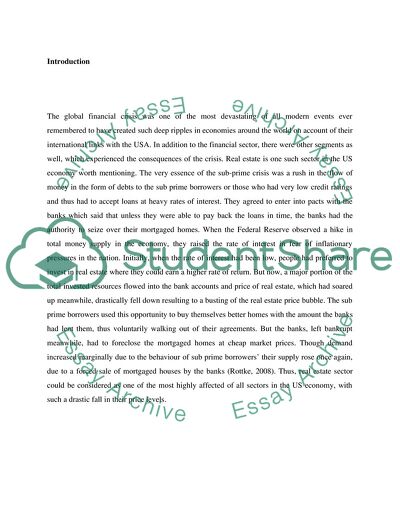
- Home
- Free Samples
- Premium Essays
- Editing Services
- Extra Tools
- Essay Writing Help
- About Us
- Studentshare
- Subjects
- Miscellaneous
- Present the case of a firm that has been negatively affected by the credit crunch and associated global recession of 2008/9. a. Reference and quote materials that show how changes in the global economy are affecting firm performance and strategy. (30%) b
Present the case of a firm that has been negatively affected by the credit crunch and associated global recession of 2008/9. a. Reference and quote materials that show how changes in the global economy are affecting firm performance and strategy. (30%) b - Essay Example

- Subject: Miscellaneous
- Type: Essay
- Level: Undergraduate
- Pages: 4 (1000 words)
- Downloads: 0
- Author: hillsmerritt
Extract of sample "Present the case of a firm that has been negatively affected by the credit crunch and associated global recession of 2008/9. a. Reference and quote materials that show how changes in the global economy are affecting firm performance and strategy. (30%) b"
They agreed to enter into pacts with the banks which said that unless they were able to pay back the loans in time, the banks had the authority to seize over their mortgaged homes. When the Federal Reserve observed a hike in total money supply in the economy, they raised the rate of interest in fear of inflationary pressures in the nation. Initially, when the rate of interest had been low, people had preferred to invest in real estate where they could earn a higher rate of return. But now, a major portion of the total invested resources flowed into the bank accounts and price of real estate, which had soared up meanwhile, drastically fell down resulting to a busting of the real estate price bubble.
The sub prime borrowers used this opportunity to buy themselves better homes with the amount the banks had lent them, thus voluntarily walking out of their agreements. But the banks, left bankrupt meanwhile, had to foreclose the mortgaged homes at cheap market prices. Though demand increased marginally due to the behaviour of sub prime borrowers’ their supply rose once again, due to a forced sale of mortgaged houses by the banks (Rottke, 2008). Thus, real estate sector could be considered as one of the most highly affected of all sectors in the US economy, with such a drastic fall in their price levels.
Consider the case of Firm A, a US-based real estate developer, affected severely on account of the global sub prime crisis. The huge loss that it experienced forced the company to design its strategies once again not only to recuperate its damages but also to shield the company properly from any further shocks. There are certain issues however which need to be taken care of before any change of strategy. Firstly, it is essential to determine whether the demand and supply of real estate are elastic or inelastic in nature.
The supply of real estate is relatively inelastic in nature since it generally
...Download file to see next pages Read MoreCHECK THESE SAMPLES OF Present the case of a firm that has been negatively affected by the credit crunch and associated global recession of 2008/9. a. Reference and quote materials that show how changes in the global economy are affecting firm performance and strategy. (30%) b
ARCH modeling: forecasting the return in the UK stock market
Investigation of Financial Conservatism in the United Kingdom and China
Capital Structure of Industries in the UK
Entrepreneurship in Equatorial Guinea
European Monetary Policy and Stock Market
Financial Statement, Cash Flows, and Taxes
An Official Definition of Corporate Social Responsibility
Using Computer Programs for Quantitative Data Analysis

- TERMS & CONDITIONS
- PRIVACY POLICY
- COOKIES POLICY